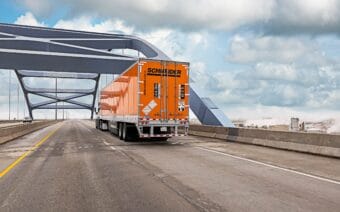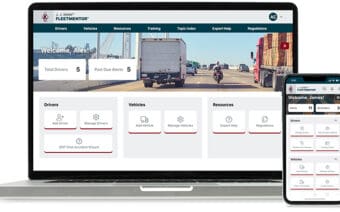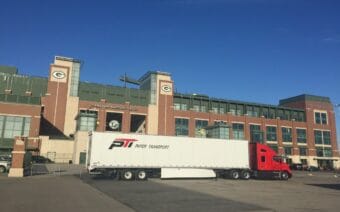
June 16, 2023
OSHKOSH – “Innovate. Serve. Advance.” – those words, John Pfeifer, president and chief executive officer of Oshkosh Corporation (NYSE: OSK), said are the essence of the company’s business strategy.
Pfeifer said they are also the reasoning behind the manufacturer’s recent plan to acquire AeroTech, a provider of aviation ground support products, gate equipment and airport services.
“We’re not a company that makes sudden moves,” he said. “We’ve been interested in adding categories in ground service equipment in airports for a long time.”
Airport service sector
As a purpose-built vehicles and equipment manufacturer, Pfeifer said, Oshkosh Corporation designs and develops products that serve a specific need in industry.
The company, he said, already has a connection with the airport service sector through its manufacturing of airport rescue and firefighting vehicles.
“It’s a fantastic product for us,” he said. “It’s a product that is really important, but you hope you never see it, because it’s the truck you see when something is wrong.”
Pfeifer said AeroTech – a JBT Corporation (NYSE: JBT) company that provides services to commercial airlines, airports, air-freight carriers, ground handling and military customers – is a good fit with what Oshkosh already offers.
“We’ve always seen there’s a lot of ground service equipment – these are purpose-built vehicles – we think we could do a good job because they would fit into our portfolio nicely,” he said.
Pfeifer said like Oshkosh Corporation, AeroTech offers products that make a difference in people’s lives by supporting those in the community who do some of the toughest work.
“This is right in our sweet spot of what we know how to do,” he said. “When you think about us as a company, you commonly think of the firefighter we serve or a soldier.”
Now, Pfeifer said, “we’re serving the people who do tough work at an airport.”
“Those operating cargo loaders or moving a 777 Boeing around the tarmac,” he said. “You are moving an airplane that costs a couple $100 million – that’s stressful work, and we want to make it as easy, safe and productive as possible.”
Pfeifer said the acquisition of AeroTech helps Oshkosh Corporation add a new category to its portfolio, and allows it to grow as a company.
“When you listen to the United Airlines CEO or the Delta Airlines CEO, they all talk about needing to add capacity, add capacity, add capacity,” he said. “We help them add capacity, because when they add capacity, it’s not just an airplane, it’s an airplane plus all the support that has to go with it. It’s good growth for us as a company, and we think we can provide a lot of value to those customers and those people who do that tough work.”
It’s all about timing
Pfeifer said the AeroTech acquisition now makes sense for both parties.
“We’ve known JBT for a few years – we’ve had a relationship with them,” he said. “The timing was right from their perspective, and from our perspective, this was the time we could acquire that business and was the time JBT was willing to sell it to us.”
//17bec5072710cda5b8dd81b69f4c6e58.cdn.bubble.io/f1686939464339x458863351241509700/richtext_content.webpLike Oshkosh Corporation, John Pfeifer said AeroTech provides products that support those who do some of the toughest work. Photo Courtesy of Oshkosh Corporation
Pfeifer said the acquisition is anticipated to be complete in early quarter three.
“There are regulatory hurdles because these are all new categories for us,” he said. “There aren’t any antitrust hurdles we need to worry about – so it should be pretty expeditious.”
Once the transaction is over, Pfeifer said Oshkosh Corporation will move forward with prioritizing where updates and improvements will happen.
“(We’ll look at) where we’re going to do engineering work and how we’re going to mutually work with one another to improve the supply chain for both companies,” he said. “We will start integrating how we’re going to work together as AeroTech becomes an Oshkosh company.”
People, leadership, values
Pfeifer said one of the first things addressed in the Oshkosh Corporation acquisition process is the people, leadership and values of the company.
“Because the culture is really important,” he said. “If there’s not an alignment on the culture, and we don’t think the people are good, then we tend not to want to make an acquisition. But we liked the people at AeroTech, we liked their culture and we think it’s a good fit for us.”
As a Midwest-style company, Pfeifer said Oshkosh Corporation tends to be humble, but confident.
“That is also how AeroTech is,” he said.
Pfeifer said the company’s 2,000 employees – located at two locations on opposite sides of the country, one in Florida and the other in Utah – will remain with AeroTech.
“That’s an important thing for us, to keep those people – people are everything to a company,” he said. “It doesn’t matter how many patents you have, how much technology you have, how many manufacturing plants you have, if you don’t have good people, and you don’t take care of people, then you really have nothing.”
Pfeifer said making the transition from a JBT company to an Oshkosh company a successful one for employees is about communication.
“It includes communication about what’s different between Oshkosh benefits and it’s like being a team member at Oshkosh versus JBT,” he said.
However, as two publicly traded companies, Pfeifer said it’s pretty straightforward.
//17bec5072710cda5b8dd81b69f4c6e58.cdn.bubble.io/f1686939506643x292194148513299260/richtext_content.webpAeroTech manufactures purpose-built ground service vehicles and equipment used at airports. Photo Courtesy of Oshkosh Corporation
“They’re a big organization, so they have similar benefits and a similar structure with their people as we do,” he said. “There’ll be some differences in terms of how different benefits work, but there won’t be any major gaps that people get concerned about.”
Financials
The definitive agreement to acquire AeroTech includes an $800 million all-cash transaction.
Pfeifer said when adjusted for the present value of expected tax benefits of approximately $80 million, the purchase price is $720 million.
Oshkosh expects to fund the transaction through a combination of cash on hand and capacity under its current revolver.
Following the close of the transaction, Oshkosh anticipates a debt/EBITDA leverage ratio of approximately 1.5x, a ratio that remains under its target of 2x debt/EBITDA.
Pfeifer said the acquisition is expected to deliver a return on invested capital (ROIC) in excess of 10% by the third year following close.
The acquisition, he said, is expected to be accretive to Oshkosh’s growth and margins and deliver solid recurring revenue from its aftermarket parts and services offerings.
AeroTech’s recurring revenue, together with the distinct investment cycle and demand dynamics of its end markets, Pfeifer said, are expected to further enhance Oshkosh’s overall business through market cycles.
“AeroTech meets all the criteria of our M&A priorities, and we believe it will enhance the financial profile of our vocational segment, further strengthening this growing segment and enabling it to move beyond our goal of $3 billion-plus annual revenue with double-digit margins,” he said. “We look forward to working with the AeroTech team to integrate the business and unlock value for our customers and shareholders.”
Moving the company forward
Upon closing, AeroTech will become part of the Oshkosh Vocational segment – which also includes Pierce, Airport Products (ARFF) and Frontline Communications brand.
The products AeroTech manufactures, Pfeifer said, are similar to the products Oshkosh’s vocational segment already creates.
He said AeroTech has systems in the field that serve approximately 75% of air travelers at U.S. airports and load approximately 70% of the world’s overnight express packages.
Pfeifer said Oshkosh intends to advance the technology of AeroTech products.
“We’re going to go from diesel and lead-acid power to lithium-ion powered vehicles,” he said. “We know how to electrify purpose vehicles. Our technology fits well with what Aerotech needs to do, and we’ll be able to help facilitate that with our technology and engineering capability.”
 Farm to School benefits students, local businesses
Farm to School benefits students, local businesses Making a Difference: This year’s Bart and Cherry Starr award recipient bleeds Green and Gold
Making a Difference: This year’s Bart and Cherry Starr award recipient bleeds Green and Gold








